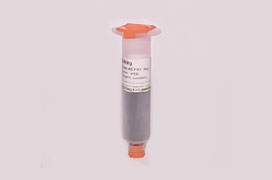E-linking manufactures a wide range of adhesives for bonding metals to metals, as well as metals to other substrates. Surface preparation plays a key role in ensuring that good bond strength is achieved. The following techniques are typically used as practices for proper surface preparation:
Degreasing
Degreasing is carried out in order to remove any loosely held dirt or other contaminants from the surface. Surfaces can be degreased using volatile solvents such as toluene, acetone, methyl ethyl ketone, methyl alcohol, isopropyl alcohol and trichloroethylene. However, kindly make sure that all the environmental, health and safety regulations are met prior to selecting a solvent. The most common methods used, typically include the three main steps:
Vapor degrease/clean/rinse the parts with the appropriate solvents
Immerse the substrates in a fresh bath of solvent for the wash and follow by an immersion in the second tank for a rinse
Cleaning and drying the substrate post the degreasing
Abrasion
Mechanical abrasion of smooth surfaces is employed in order to remove heavy loose surface deposits such as dirt, oxide layers or any other contaminants that might be deposited on the surface. Some of the most effective mechanical methods used include sand blasting, wire brushing and abrasion with sandpaper or emery cloth. The surfaces need to be degreased and cleaned before as well as after abrasion to remove any pre-existing contaminants on the surface. Once the surfaces have been abraded, they need to be degreased to remove the debris from abrasion.
Dry abrasion is a mechanical technique where the operator hand sands or wire brushes the substrate with a medium abrasive material. But, this technique is highly dependent on the user and care should be taken to achieve consistent results. Abrasive blasting tends to be preferred as it is a fast, efficient and highly controlled technique. Sand blasting or other techniques are typically employed to achieve this. An RMS of about 150 (microinches) to 250 (microinches) is generally recommended for metals. Please note caution must be exercised based on the exact material used eventually on the feasibility of this technique.
Chemical Treatment
Specific chemical techniques have been developed for treating different substrates. These treatments change the physical as well as the chemical properties of the surface in order to improve the adhesion. A wide range of acids and alkalis are used for this purpose. Typically the specific chemical or a mixture of chemicals is placed in a chemically resistant container. The chemical bath is then heated to the appropriate temperature and the metal is immersed in the chemical bath for the required amount of time. After chemically treating the surfaces, it is important to rinse the surface with DI water and thoroughly dry the surface before it is subjected to further use. Extreme care should be taken while handling chemicals. Good laboratory skills should be used while handling these chemicals. The personnel should be wearing the appropriate personal protective equipment and should be well trained in handling these chemicals.
















 Adhesives, Sealants and Coatings for the Aerospace Industry
Adhesives, Sealants and Coatings for the Aerospace Industry





